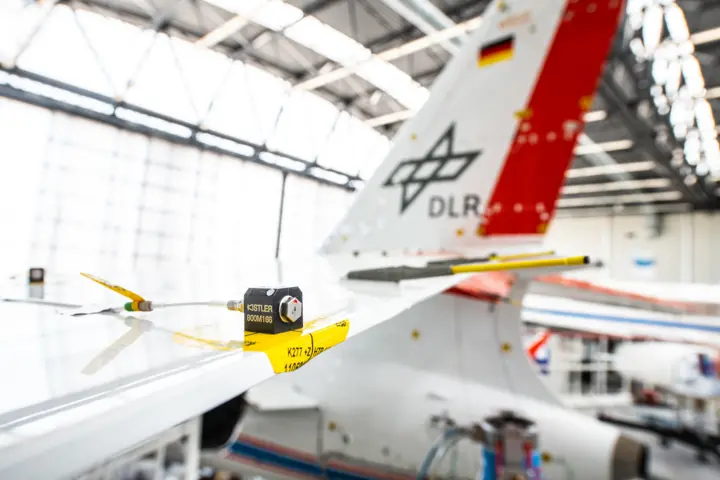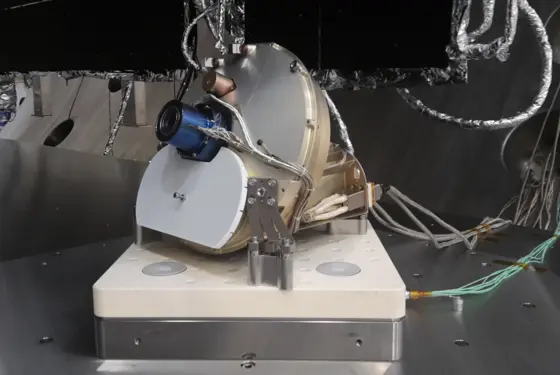The right measurement technology for every testing requirement
Julian Sinske joined the DLR in 2013 and he has held the post of Teamleader Structural Dynamic Tests since 2018. He explains the goals and conditions for a GVT: “Generally speaking, the ground vibration test only takes place six to eight weeks before the maiden flight – and with that timescale, the procedure has to be performed efficiently. For the test, the aircraft is mounted so that its behavior is similar to its in-flight behavior – with damping influences due to the landing gear and tires excluded as far as possible. The experimental results from the GVT can be used to validate the manufacturer's simulation model. In most cases, this is the prerequisite for further in-flight testing of the prototype.”
Over 200 IEPE accelerometers from Kistler were used for the ground vibration tests on ISTAR (In-flight Systems & Technology Airborne Research), the new research aircraft that joined the DLR's fleet in 2020. In addition to these instruments, 62 more IEPE (PiezoStar) and capacitive MEMS accelerometers (K-Beam) from Kistler are permanently installed in ISTAR for in-flight testing. Frank Busch, a Sales Engineer at Kistler, explains how these applications differ: “The MEMS sensors, which measure statically, also take account of gravitational acceleration because they are optimized for low frequencies in the 0 to 50 Hz range. That means they can record the aircraft's flight maneuvers at the same time. In this ground vibration test, the MEMS and IEPE sensors installed permanently in the aircraft could be operated in parallel with the dynamic IEPE sensors and compared with them. The GVT sensors are affixed to the outside of the plane – just temporarily, only for the duration of the test.”
All of these instruments form part of a comprehensive measurement system that the aeroelastics specialists headed by Julian Sinske use to continuously record all the ISTAR data, which they can then evaluate over periods of many years. “By taking this Big Data approach, we create the basis for the digital twin – and that allows us to set up structural health monitoring, for example,” he notes.
"We’ve been collaborating successfully with Kistler ever since we first made contact with them at the Space Tech Expo some years ago. We use their sensors for projects involving both large and small aircraft, and also in the wind power segment."
Julian Sinske, Teamleader Structural Dynamic Tests at the Institute of Aeroelasticity, DLR
Robust, flexible instrumentation – plus temperature stability
Kistler was also selected to equip the ISTAR research aircraft – thanks in particular to an outstanding innovation. The single-axis transducers for the GVT feature a measuring element mounted so that it can be rotated. This allows flexible alignment of the sensor in two spatial directions. “As the result, specific parts of the aircraft can be instrumented differently without sacrificing measurement channels for three-axis sensors, for example,” Sinske adds. This is why the DLR and the Institute are so highly satisfied with Kistler: “Several factors influenced our decision to opt for Kistler's flight test sensors: the high temperature stability of the IEPE sensors and the high signal quality of the MEMS sensors, combined with good advisory support – especially from Dr. Thomas Petzsche. The measurement equipment was ready to operate from day one, and it was equally convincing in terms of design and cost efficiency.”
For the GVT, the research aircraft was excited at about 10 points in succession – often symmetrically, and at several excitation levels so that nonlinearities could be detected and closely adjacent modes could also be differentiated. A taxi vibration test (TVT) has already been performed as well. In this case, the aircraft moves out of the hangar and across the runway at the DLR's Research Airport in Braunschweig; this allows determination of its vibration behavior while it is traveling slowly. The team continued to perfect the methods and procedures as the tests were carried out. As part of a research project on data evaluation, for instance, an AI algorithm was used to achieve faster evaluation and eliminate the human factor. “But it's not yet good enough to replace an experienced engineer – especially in difficult cases,” Sinske points out with a smile.
Data evaluation with the help of artificial intelligence
Students at the Institute have also developed an augmented reality app that can be used on a smartphone to check and simultaneously document the presence of each sensor, including its number, alignment and position, etc. In some cases, over 500 sensors have to be positioned with an accuracy of one centimeter – so this innovation makes the work far easier. “Setups of this sort often have to be completed in just a few days by people working shifts. So it's important to discover any anomalies as quickly as possible, for example if a sensor comes loose or the cable is not plugged in correctly. The earlier the fault is detected during that hectic phase, the less chance there is of falsified measurement results once the action really begins,” Sinske continues.
The Ground Vibration Test and Taxi Vibration Test results have already undergone comprehensive evaluation, and a start has also been made on updating the aircraft manufacturer's computer model. Thanks to these efforts, the aeroelastic part of the digital twin for the ISTAR research aircraft is now within reach. Julian Sinske's final comment: “We're highly satisfied with the way Kistler has implemented the measurement technology. The sensors are robust and they perform excellently. That's why we've already put in several repeat orders, including different cable lengths of one, two, five and ten meters. With so many sensors, this always allows us to ensure optimal cabling – as short as possible – so routing of the signals is guaranteed. We will definitely be opting for solutions from Kistler for future projects in other fields too – such as spaceflight, wind power or innovative air taxis.”








![Bend – but don’t break [object Object]](https://kistler.cdn.celum.cloud/SAPCommerce_Document_Preview/961-609e.webp)
![Piezoelectric accelerometer with mounting block for precise modal analysis [object Object]](https://kistler.cdn.celum.cloud/SAPCommerce_Document_Preview/999-236e.webp)